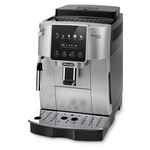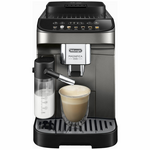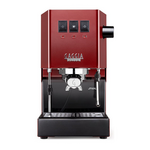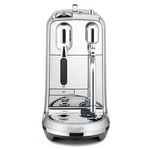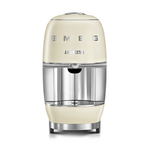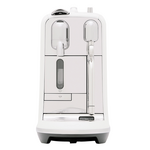
How to choose the right coffee machine for your home
Australia’s relationship with coffee has come a long way since the 1950s, when it was pioneered by new European migrants to Australia. That post-war period was the beginning of Australia’s transition from being a land of tea sippers to a nation of coffee drinkers. Today, it’s not just a ritual for millions of us, it borders on a national obsession. It may only be a matter of time before International Coffee Day is declared a national holiday!
Being a coffee aficionado doesn’t mean you love all coffee, of course - if anything, the deeper your passion for the dark elixir, the more discerning you’ll be. In the past, cafes were the only place most of us could guarantee a proper brew, but technology has evolved and now we have numerous options for making great quality coffee at home - some of them almost foolproof.
If you’re buying a coffee machine you’ll want one that matches both your practical needs, in terms of convenience and cost, and your preferences in terms of taste. In this article, we’ll look at the key areas to consider when choosing the right type of coffee machine for you.
What are the main types of coffee machine?
The coffee you buy in Australian cafes is made with a shot of espresso as its base. Your three options for making espresso at home are manual, automatic or capsule espresso machines. Each style of machine has its pros and cons, as you’ll see.
How do you use home coffee machines?
Espresso is made by using high pressure to force hot water over finely ground coffee powder. This shot of caffeinated magic, with its rich, foamy ‘crema’ head, then forms the heart of whatever cup of coffee you’ve ordered - or are making. From a macchiato or long black, to a latte or that great Australian creation, the flat white, espresso is the foundation.
The technique varies slightly by the type of espresso machine being used.
Manual coffee machines
With a manual coffee machine (also known as a semi-automatic), you collect coffee powder (either freshly or pre-ground) into the group handle and firmly compress (tamp) it, before fixing it to the machine’s group head for hot water to be expressed over it, resulting in a shot of espresso.
Automatic coffee machines
Automatic espresso coffee machines freshly grind the beans, tamp the resulting powder, and express pressurised hot water through it to create an espresso - while collecting excess powder and waste to be emptied later.
Capsule coffee machines
A capsule coffee machine (think Nespresso) uses single-use sealed coffee pods filled with ground coffee powder. It pierces the coffee pod and injects it with hot water at high pressure to produce a shot of espresso.
Do you need a milk foamer and coffee grinder?
If you want to make anything other than short and long black coffees, you’ll need a milk frother or steam wand. Without one, you’ll struggle to get the creamy head on your cappuccino or latte. Some models have these built-in, while others will require you to buy a separate machine or device.
If you want the freshest tasting coffee, you'll need to grind the coffee beans just before you make your drink. Automatic espresso machines have built-in grinders, but not all manual coffee makers do. If the unit you have your eye on doesn’t have one built in, you’ll need to buy a separate coffee grinder, so factor this in when comparing models.
How important are these features to you?
For some people, a great coffee is worth waiting for, while for others speed is of the essence. The importance you place on everything from convenience and consistency, to freshness and price, will affect your decision when buying a coffee machine.
Convenience and speed
If your mornings are a whirlwind, then speed and convenience will be priorities when it comes to making your cup of Joe to go. No time for experimentation and creating unique house blends. In this case, automatic and capsule machines are your friend, as they require the least time, effort and, often, clean-up. Without the need to manage the bean grinding and tamping (and for some models, milk frothing), you can be out of the door sooner.
Consistency
We generally don’t want variation in the flavour of our long black or cappuccino. That first sip of your favourite coffee is something approaching sacred, and a bad, or even just different, cup can burst this bubble. It’s why so many of us are loyal to our favourite cafes - it’s for their consistency, not their ability to surprise us.
For home coffee machines, automatic and coffee pod machines standardise the whole process, so there’s next to no room for the ‘human error’ that can spoil your brew. If you’re happy to risk variations for the sake of getting more hands-on with your coffee making though, a manual machine allows that ‘risk and reward’.
Authenticity
You want to achieve a flavour that’s as close as possible to your barista-made coffee. To do this, you’ll want either a manual machine (if you want to be more involved with the grinding and tamping) or automatic coffee machine. Either way, you get the cafe-style freshly ground beans taste (as long as your machine incorporates a bean grinder or you have a separate grinder).
Freshness
Coffee begins to deteriorate as soon as the beans are ground, so the sooner you can get it into your cup after grinding, the better. Manual and automatic coffee machines are the winners on this front (as long as they include a built-in bean grinder, or you have a separate grinding unit). Capsules contain pre-ground coffee which, although sealed for freshness, won’t have quite the same flavour profile as beans that have been blitzed just moments before.
Artistry
For some people, half the pleasure of having a coffee machine is the pride they can take in creating the perfect brew for guests. Whatever their usual profession, at home they want to be a bona fide barista. There’s an undeniable satisfaction that comes with making anything manually, whether it’s baking a cake from scratch, or hand carving a chess board. Making a coffee that elicits sighs of pleasure from friends and family is no different.
For maximum kudos on this front, a manual machine is the only way to go. It’s more effort, more prone to human error and usually involves more cleaning. But, once you perfect your technique, the glory tastes almost as sweet as the coffee.
Cleaning
Regardless of the type of coffee machine you have, you’ll need to do a little cleaning to keep it working properly and making fresh-tasting coffee, though capsule models are generally a bit easier to maintain. Regularly rinsing the system through prevents the build-up of limescale (calcium) that can affect how well the machine works and how good the coffee tastes. It also prevents the accumulation of coffee oils that can turn rancid over time and give coffee an unpleasantly bitter edge.
How to clean and descale your coffee machine
To clean the machine, every couple of months you can add a specific cleaning solution to the water tank and run a few cycles. Some automatic coffee machines have a self-cleaning function, and while this doesn’t mean that you have no cleaning to do, it does help by advising when the machine needs a good rinse.
In addition to the internal components of the machine, you’ll also need to regularly drain the drip tray of water and coffee. For automatic and manual machines, you’ll need to empty out and clean the used coffee grounds tray after several uses, to prevent mould and stale smells. This isn’t necessary for capsule coffee machines, because the coffee grounds remain within the pod, which drops into a waste compartment.
The steam wand and any other milk frother components, like the milk container, will also need to be wiped down and cleaned after each use.
Price
You can get cheaper models in all categories, but generally automatic coffee machines will cost more. Automatic coffee machines start from around $300, and average around $1,500, with a handful of very high end built-in machines costing up to $7,000.
Manual coffee machines start from under $200, and average around $900 with very high end models going up to $10,000. Remember that lower priced manual coffee machines may not include a bean grinding function, so if you want to make coffee from freshly ground beans you’ll need to buy a grinder separately. Likewise, a milk foaming/steaming function may not be included and therefore may need to be purchased.
Capsule coffee machines start from under $200, and average around $400, with higher end models going up to around $1,000. While the initial outlay is often less than with other types of coffee machine, the ongoing cost of the pods can be higher than buying coffee beans or grounds. Pods can cost around a dollar each shot, whereas good quality coffee beans, and pre-ground coffee, can make shots for closer to 30 cents each.
Size and style
Unlike some kitchen appliances, a coffee machine is likely to live on your kitchen benchtop, rather than be put away between uses. Therefore, you’ll want to choose a model that fits comfortably in the space and complements it.
Automatic espresso machines are generally the biggest of the home espresso makers, followed by manual machines, with capsule pod coffee machines the most compact. The inclusion of bean grinders and milk frothers can make the machine larger, but remember that smaller models may be more slimline because they lack these features and you’ll need to buy them separately - and these will take up additional space.
Reliability and warranty
The more complex any type of machine, the more that can potentially go wrong with it - coffee machines included. It’s always a good idea to check online star ratings to see how genuine customers rank a machine (ideally a good number of reviewers rather than a handful), and reading the reviews to see if there are recurring mentions of any technical issues in that model or other models from that brand.
It’s worth noting that with most consumer products, higher end models will have fewer customer ratings, simply because lower priced models will have been purchased, and therefore rated, by more people. In these instances, it’s best to compare with models that have a similar price range and functionality.
Automatic coffee machines are generally more complex, and more expensive, and usually have a 2-year warranty (a few higher end models have longer warranties). Manual coffee machines will generally have either a 2 or 1-year warranty. Most capsule coffee makers have a 2-year warranty.
Manual, automatic and capsule coffee machine comparison
Manual | Automatic | Capsule | |
|---|---|---|---|
Convenience & speed | ✅ | ✅ | |
Consistency | ✅ | ✅ | |
Authenticity | ✅ | ✅ | |
Freshly ground beans | ✅ | ✅ | |
Artistry | ✅ | ||
Ease of cleaning | ✅ | ||
Size | Medium | Larger | Smaller |
Price (avg) | $$ | $$$ | $ |
Warranty | 2 or 1 year | 2 year | 2 year |
Alternate home coffee techniques
These are not espresso makers, so will not produce the rich, intense shots that are the basis of Australian cafe-style coffee. If you’re sticking to a lower budget or need to make larger quantities of everyday sipping coffee, however, they’re a potential alternative.
Filter coffee (brewer)
Also known as drip coffee, this is the type of brew you might expect to be poured by your waitress in an American diner. Water is heated and pumped over coffee powder, slowly seeping down into a reservoir. More of a traditional cuppa Joe than the barista-style coffee Aussies love, it’s not one for the aficionados, but it has convenience on its side. If you want a jug of coffee big enough to fill several cups, and that stays warm for hours - maybe in a small workplace or big family - this can be a good option.
French press (cafetière)
Patented in 1920’s Europe, this method has stood the test of time. It’s essentially a brewer in which medium-sized coffee grounds are steeped in hot water before being separated from the resulting liquid with a plunger. Unlike filter coffee brewed with drip brewers, however, the plunger is fine enough to separate the grounds without losing the naturally occurring oils from the coffee beans, which provide flavour and ‘mouth feel’.
A modern variation on the cafetiere is the Aeropress: popular with travellers, it makes a single cup and uses a finer filter, which removes the oils from the coffee beans. This results in a ‘cleaner’ coffee taste, but without the richness and body that many enjoy in their coffee.
Stovetop moka pot
This classic Italian coffee pot uses steam pressure to push boiling water through fine coffee grounds. The coffee it makes is probably the closest thing to espresso (compared to these other alternatives to espresso machines), but it isn’t a ‘true’ espresso. This is because the pressure used to push the boiling water through the coffee grounds is only about 20% of that achieved by espresso machines, which results in a less concentrated shot of coffee and doesn’t produce the famous espresso crema.
Percolator
This technique appears similar to the moka pot method, as it’s a stovetop (or electric) coffee pot, but it varies in that it slowly trickles boiled water through medium coffee grounds, resulting in a weaker coffee than the moka pot, which uses high pressure to push water vapour through finely ground coffee.
Percolators have become less popular since the 1980s, with the arrival of newer and, generally, better methods (like home espresso and drip filter machines)
Pour over coffee
A clean and simple technique, you place coffee grounds into a conical paper filter in the neck of a, usually, glass flask, and pour boiling water over them. The result is lighter than with French press, because the coffee grounds don’t steep in the water, and the filter removes not only the sediment, but also most of the oils, which would otherwise provide richness and mouth feel.
Instant
That’s not why you’re here.
What’s the best coffee machine for you?
Like many of life’s pleasures, coffee is subjective. Great coffee is the type you enjoy the most. If the satisfaction of controlling the entire process enhances that enjoyment for you, then a manual coffee maker will set you on the path to being a home barista.
If you just want consistently great, freshly ground coffee at the touch of a button, then an automatic model will be the best coffee machine for you. If you’re happy to forego the fresh grind for a quicker and simpler alternative, a capsule coffee machine can still make you a really good coffee.
Become a home barista sooner with free next day delivery!
We deliver coffee machines, and the rest of our products, to 95% of Australia’s population with Appliances Online's legendary FREE delivery - and we can usually get it to you by the next day (Mon-Fri) as long as it's in stock. Plus, we now offer paid Same Day Delivery for in-stock appliances in NSW, QLD, and VIC metro areas if you order before 12pm Mon-Fri.
As part of our commitment to sustainability, we'll also take your old disconnected kitchen appliances away for recycling, for free. Check out our full range of manual, automatic and capsule machines and if you need a few more tips on choosing the right model for you, check out our Coffee Machine Buying Guide or call our friendly team 24/7 on 1300 000 500.



